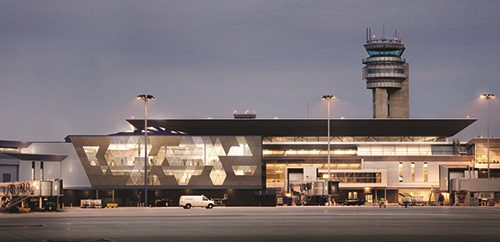Montréal-Trudeau International Airport (YUL) opened the first phase of its new two-story Connection Centre last December. The diamond-shaped facility, which is elevated over an airside road, will soon centralize processing for all passengers arriving on transborder and international flights en route to airports elsewhere in Canada and throughout the world.
Montréal-Trudeau International Airport (YUL) opened the first phase of its new two-story Connection Centre last December. The diamond-shaped facility, which is elevated over an airside road, will soon centralize processing for all passengers arriving on transborder and international flights en route to airports elsewhere in Canada and throughout the world.
Facilities completed during Phase 1 are already serving passengers who arrive on U.S. and international flights, and then connect to Canadian and international destinations (other than the U.S.). Phase 2, scheduled for completion by the end of this summer, will add specific facilities for passengers arriving on international flights who are bound for the U.S. After Phase 2 is finished, YUL will add a vertical block that integrates all connecting routes and separates international and domestic passengers.
The $50 million project is funded wholly by ADM Aéroports de Montréal, the airport authority that manages, operates and develops YUL and International Aerocity of Mirabel (YMX).
|
Project: Connection Centre Location: Montreal-Trudeau Int’l Airport Owner/Manager: Aeroports de Montreal Cost: $50 million Timeline: Construction began in 2017; Phase 1 opened Dec. 2019; Phase 2 slated to open late summer 2020 Design Architect: Jodoin Lamarre Pratte architectes Inc. Construction Manager: Pomerleau Building Structural Engineers: NCK Mechanical & Electrical Engineers: Tetra Tech Telecommunication Engineers: SNC-Lavalin Telecom Video Surveillance & Access Control: SNC-Lavalin Access Control Civil Engineers: EXP Signage: Signature Design Communication Publicity/Advertising: Acoustec Traffic & Road Sign Engineers: CIMA |
The new Connection Centre at YUL is opening against the backdrop of increasing traffic levels. The airport’s overall passenger volume has been rising for several years, and connecting traffic is fueling much of the growth. Last year, YUL served more than 20 million travelers, an increase of 4.5% over 2018. Of those travelers, 20% were connecting passengers—a segment that has grown by an average of 9.2% every year since 2016.
Niki Elias, assistant director of airport infrastructures for Aéroports de Montréal, describes the new Connection Centre as an essential asset for air service development that will confirm YUL’s status as a key hub for international travel. Nearly 1 million connecting passengers are expected to use the facilities as a gateway to China, Turkey, the Middle East, Japan and North Africa.
The overarching goal for the addition is to provide connecting passengers with a more fluid and expedient journey. Specific objectives include: increasing processing capacity; centralizing connection processes; improving passenger orientation and overall customer experience; and ensuring flexibility of facilities.
“It is important for an international airport to have a significant share of connecting passengers for the development of new routes and to ensure its competitiveness,” says Elias. The new Connection Centre is designed to help achieve both outcomes.
In 2019, YUL served 152 destinations, 90 of which were international.
Features & Challenges
Located between gates 72 and 56 at the junction of the transborder and international jet bridges, the new Connection Centre includes 36 Primary Inspection Kiosks. This makes the flow of transit passengers arriving at YUL more efficient, Elias explains.
Level 2 includes a new CATSA checkpoint for passengers connecting to international destinations. Above, on Level 3, the connection hall houses Customs operations operated by the Canada Border Services Agency for those passengers connecting to domestic destinations. Counters here are specially designed to accommodate passengers who require extra assistance.
The 3,000-square-meter facility is elevated above an airside roadway—a configuration that presented formidable challenges for engineers and construction crews alike. Structural engineers from NCK rose to the occasion by suspending the all-steel building from the roof above with an inventive system of beams and columns to prevent sway. Because the suspended structure would not enjoy insulation benefits from the ground below, the heating system was more important than usual to maintain a comfortable ambient temperature inside the Connection Centre.
Construction required great attention to the airport’s ongoing operational requirements. Elias reports that careful coordination during airside work led by Pomerleau ensured the safety and security of the 13,000 employees who work at YUL and the 55,000 travelers who pass through it on an average day.
“To fully appreciate the scope, it is necessary to understand the reality of an airport environment that is, by definition, a place that never closes,” she comments.
 Symbolic Shape
Symbolic Shape
The Connection Centre was specifically designed to convey Montreal’s welcoming character. Because the facility serves transit passengers, the airport wanted the aesthetics and layout to leave passengers with a “memorable impression of their short stay in our city,” explains Elias.
Jodoin Lamarre Pratte architectes Inc., which led the design efforts, focused on making the new facilities bright and relaxing to evoke the hospitable culture and charm of Montreal, Quebec and Canada. “We tried to give a good taste of Montreal, but in a very short time for people just passing through,” says Nicolas Ranger, a senior partner with the firm. “This small taste will hopefully entice them to come back and spend more time in the territory.”
“A connection center is a place of passage, a crossroads, a hub between a multitude of possible destinations,” Elias adds. “This function inspired the architectural team to create a triangular grid where lines intersect, converge and diverge.”
Airport management wanted to visually link the new addition to YUL’s existing terminal, but also make it clear that the Connection Centre has a different function than the rest of the airport. Designers consequently opted for a triangular shaped envelope, which differs from the horizontal orientation of existing facilities. “It’s a dynamic and different shape that reflects different directions travelers can take when passing through Montreal,” Ranger explains. “It was a way of expressing the short and dynamic passage of travelers into the architecture.”
 The design also pays homage to Canada’s distinctive geography. The façade, which features a grid of full and empty spaces, portrays the landscape of the Canadian Shield when viewed from the air.
The design also pays homage to Canada’s distinctive geography. The façade, which features a grid of full and empty spaces, portrays the landscape of the Canadian Shield when viewed from the air.
The interior features local and Canadian materials, including Atlantic black granite flooring, birch wood wall panels and a “green wall” of live foliage. A large skylight provides natural light for the largely wide-open space.
“We wanted a warm building, a warm feeling when people are coming in,” says Ranger. “But it is linked to our territory as well.”
Common materials and color palettes between the existing and new buildings allow the facilities to complement one another. “We didn’t want to go too far from the existing design, but wanted it to have its own distinctive character,” he adds.
The 3,000-square-meter addition was designed to be flexible and facilitate different processes for various travelers connecting through YUL. An open floor plan with efficient vertical circulation routes between the two levels allows the airport to adapt the space as traveler needs evolve, Ranger points out.
Sustainability was also a key consideration for the project, as it is with all airport authority projects, notes Elias. For example, a green wall was installed near the waiting area before Customs controls to improve air quality and reduce stress for passengers. It is also strategically placed against the main mechanical shaft, allowing for connection to the ventilation system and air humidification. Plants in the green wall are illuminated by artificial lighting on the ceiling.
A solar wall on the south façade of the westernmost part of the facility leverages sunlight to heat the air and ventilate the building. This sustainability feature will reduce the use of the HVAC system and lower associated energy costs.

Project Partnership
Elias emphasizes that active involvement of all operating partners is key for this ongoing project. She says that partnership was vital to the successful commissioning of Phase 1—from space design and new passenger processes, through active operation.
“All key partners were involved during the preparations for commissioning (sprints), including operators, airlines and security teams, as well as communications and maintenance teams,” Elias specifies. “Many sprints took place at the same time to maintain engagement and ensure the effectiveness of efforts.”
Preparation for commissioning took approximately three months.
Several methods and processes were used to ensure that the new facilities would meet operational expectations, she adds. Building Information Modeling was used during the design phase to simulate processes in a three-dimensional virtual space. Later in the schedule, stakeholders participated in onsite visits and pre-operational simulations. The Canada Border Services Agency, CATSA, Air Canada and Air Transat also worked in close partnership on the Connection Centre project and validation process.
The Canada Border Services Agency and CATSA will be the main operators in the facility.


 facts&figures
facts&figures

